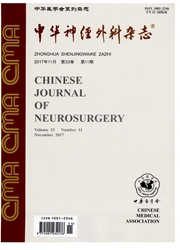

 中文摘要:
中文摘要:
目的在细胞及突触水平探讨外伤后癫痫的发病机制。方法自由落体致伤法制备大鼠颅脑创伤模型,采用膜片钳技术监测海马CA1区锥体细胞内在电生理特性和局部突触兴奋性的变化。结果颅脑创伤后,大鼠CA1锥体细胞膜输入阻抗和时间常数增加,动作电位的阈电流降低;给予配对刺激后,海马CA1区兴奋性突触后电流表现为配对脉冲比率的降低及配对脉冲易化向配对脉冲抑制的转变。结论颅脑创伤后海马CA1区神经元内在兴奋性和突触传递功能增强,这些改变可能是外伤后癫痫发病的重要原因。
 英文摘要:
英文摘要:
Objective To explore electrophysiologic mechanisms underlying posttraumatic epilepsy on the cellular and synaptic level. Methods Whole cell voltage - clamp recordings were used to examine intrinsic excitability and evoked synaptic events from CAl pyramidal cells in slices prepared from fluid percussion injury (FPI) rat at various times after the brain injury. Results We find that CA1 pyramidal cells in FPI rats show : ( 1 ) increased membrane input resistance and time constant, and decreased threshold current of action potential, ( 2 ) decreased paired - pulse ratio ( PPR ) and a shift of paired - pulse facilitation (PPF) to paired - pulse depression (PPD), which may suggest increase of presynapse transmitter release probability. Conclusions These findings suggest that there is trauma - induced increased intrinsic excitability and synaptic excitation on the cellular level in the rat hippocampus CA1 following cortical contusion head injury. These alterations may facilitate the progress towards the development of epilepsy.
 同期刊论文项目
同期刊论文项目
 同项目期刊论文
同项目期刊论文
 期刊信息
期刊信息
